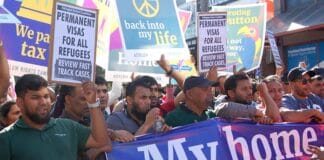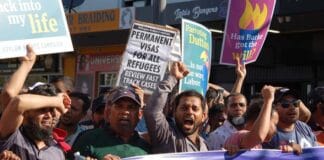Tamil Tigress
By Niromi de Soyza
Allen & Unwin, $32.99
Tamil Tigress is the memoir of Niromi de Soyza, who in 1987, at the age of 17, left her middle-class family to join the Tamil Tigers. De Soyza, who now lives in Sydney, says the impetus for writing the book came from the re-emergence of racist anti-refugee hysteria as boats of Tamil asylum seekers arrived in Australia.
The book was intended to raise awareness about their plight. It is a detailed and personal account of the civil war that engulfed Sri Lanka for 37 years.
As well as providing a personal story of civil war in Sri Lanka, Tamil Tigress gives an insider’s glimpse into the operations of the Liberation Tigers of Tamil Eelam (LTTE, also known as the Tamil Tigers—hence the title of the book) and the politics of the Tamil national liberation struggle.
Oppression of Tamil Minority
Niromi’s story begins with her move, in 1977, from the Sinhalese-majority city of Kandy to the Tamil strong-hold Jaffna in northern Sri Lanka to get a better education.
Only a few months before Niromi’s departure, groups of Sinhalese killed a few hundred Tamils. The murderous riots broke out across the country after the Tamil United Liberation Front won the majority of Tamil votes in the election, standing for self-determination.
This result came in the context of a steady rise of anti-Tamil discrimination, such as the quota system introduced into universities to limit the numbers of Tamils and the “Sinhala Only Act” of 1957 that made Sinhalese the only official language of a linguistically diverse island.
In the book, the historical origins of the explosive tensions between Tamils and Sinhalese (74 per cent of the population) and the role of British imperialism, are recounted in conversations between Niromi and her father. These conversations give a glimpse of how the British employed the classic colonial strategy of divide and rule.
During British rule, the Tamil minority were used by the British to work in the public service and administrative positions during its colonial rule over the Sinhalese majority.
Post-independence, however, the British handed power to the Sinhalese majority. “Ceylon” became “Sri Lanka”, and the new ruling party (United Nationalist Party) began to emphasise virulent Sinhalese nationalism and to attack Tamils in order to divide ordinary people and shore up its own legitimacy. In this period hundreds of thousands of Tamils brought to Sri Lanka by the British to work on tea plantations were threatened with deportation to India, although their families had been in Sri Lanka for 100 years. The tensions culminated periodically with violent attacks—most notably “Black July” 1983, when groups of government sponsored Sinhalese gangs unleashed an anti-Tamil pogrom after the Tamil Tigers killed 13 Sri Lankan army soldiers. It is estimated that somewhere between 400-3000 Tamils were killed during “Black July”.
It was against this backdrop of repression, military curfews and the murders of Tamils, whose bodies were publicly displayed on road corners by the Sri Lankan government, that Niromi’s indignation about these atrocities developed into a growing admiration for the Tamil Tiger resistance. The year of 1987 was the worst year of violence committed against the Tamil minority.
Niromi, after desperately longing to join the Tigers, writing celebratory poems of struggle for an independent Tamil state and waiting anxiously for the LTTE to change their opposition to recruiting female fighters, joined the Tigers—much to her family’s dismay. She joined the Students Organisation of Liberation Tigers (SOLT) and later, the female guerrilla unit that went by the name the “Freedom Birds”. Niromi vividly describes her struggle to deal with, and overcome, her own community’s use of sexist shame to deter women from engaging in political activity—a feature that is by no means limited to Tamil society.
Unfortunately the book doesn’t explore the politics behind the rise of the Tamil Tigers, whose prominence was by no means automatic and who only became the dominant political current among Sri Lankan Tamils in the 1980s.
Tamil Tigers
De Soyza’s account of her time in the Tigers reveals a great deal about the politics of the LTTE. Most striking of all is the elitist attitude of the Tigers towards the Tamil population. This feature, common to many national liberation movements, was evident even in the early days of its guerrilla strategy. But it became even more characteristic as the Tigers came to run a mini-state in the north.
The Tigers came to be seen as the one force that could carry the hopes of the Tamils, and they had the sympathy of sections of the general Tamil population. But the Tigers saw their own armed struggle as key to the creation of an independent Tamil state, not a struggle from below for liberation involving the greater Tamil people.
While the Tigers’ leadership alluded to a revolutionary struggle for an egalitarian society, in practice it was nationalist politics and a struggle for a separate Tamil state, not a socialist Sri Lanka, that characterised the Tigers’ politics.
This was why the Tigers attracted the support of Tamil intellectuals and the middle class (like Niromi and her student friends) who had been systematically excluded from Sri Lankan society by the virulent Sinhalese nationalism that dominated after independence.
Niromi recounts a number of occasions where Tigers were confronted with pleas from the Tamil population to leave their area and not make them the victims of their struggle with the Sri Lankan army. Many Tigers saw this as ingratitude and could not understand why their sacrifices were not appreciated by those they believed they were fighting on behalf of.
The armed struggle strategy of the Tigers, while able to hold large areas of the country for a period of time, could not solve Tamil oppression for Tamils living outside the north, where they were still vulnerable to government-sponsored violence.
Instead of seeing the possibilities of resistance in a common class fight of Tamil and Sinhalese workers and the poor, the Tigers tended to see all Sinhalese as complicit with the government in their oppression.
Yet the political strategy of common struggle had played a major role in fortifying resistance to the Sri Lankan government in the 1930s. In 1953 a country-wide general strike, the “Hartal”, coordinated by left parties, brought the Sri Lankan government to its knees and forced the Sinhalese nationalist prime minister to resign.
Like the struggle in the 1930s, the general strike showed the potential of united class struggle of Tamil and Sinhalese to challenge the government.
One of the most disturbing accounts of the Tamil Tigers that Niromi recounts in Tamil Tigress is the gruesome murder of fellow Tamil Tiger members—again a feature of the politics of similar nationalist liberation struggles in the Philippines and South Africa. Alongside these murders went military action against rival political factions and organisations also fighting in the Tamil liberation movement.
What is also astounding from Niromi’s account of her experience in the Tigers was the lack of political discussion or engagement by the membership with the strategy and tactics of the organisation. Members were instructed not to discuss politics amongst themselves and were often in the dark about various political deals made by the Tiger leadership.
The other notable section in the book is the “peace accord” brokered by the Indian government. At the time, the Indian government promoted its intervention as a “peacekeeping” mission to protect the Tamils. But it quickly became clear that India had its own imperialist concerns to gain a foothold in Sri Lanka and contain any independence sentiments that might spread to its own Tamil minority in the Indian state of Tamil Nadu.
During the three years Indian “peacekeepers” were stationed in Jaffna and other parts of the north, there were numerous battles with the Tigers. The Tigers were now confronted with a war waged against them by both the Sri Lankan and Indian governments.
Given some of the senseless internal violence of the Tigers and how disastrously the Tigers’ militarist strategy ended in 2009, Niromi’s pacifist conclusions are understandable. But her denunciation of “violence against violence” misdiagnoses the Tigers’ central flaw.
Rather, it was the failure of its perspective of armed struggle for a separate state and its extreme authoritarian response to the threat to its power by the Sri Lankan government.
The rise of the “war on terror”, has been used by the Sri Lankan government to delegitimise the Tamil resistance by labelling the Tamil Tigers a “terrorist” organisation. But Tamil repression by the Sri Lankan government is just as real as it ever was. The end of the civil has brought new repression and ethnic cleansing of the Tamil minority from the villages and lands in the north.
Stories like Niromi’s are an important voice for the Tamils that have been dislocated by the civil war and continue to be persecuted by the current Sri Lankan Rajapaksa government.
The book also deserves to be read to understand why the Australian government should free the Tamil refugees who are languishing in detention centres.
Jasmine Ali





